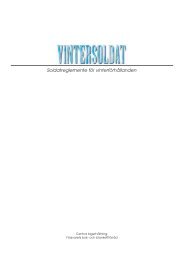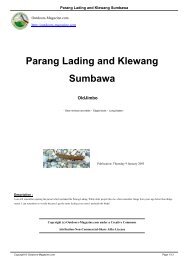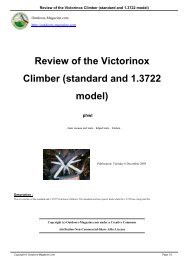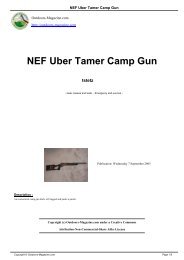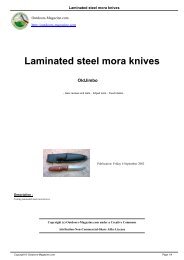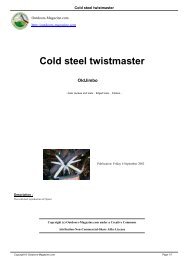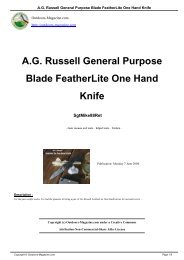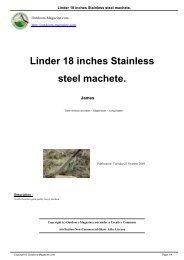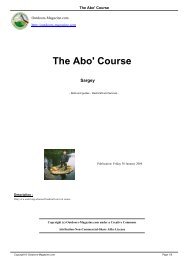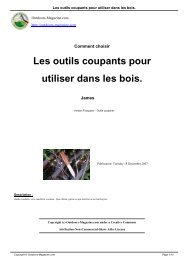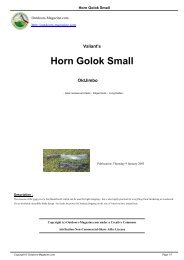Create successful ePaper yourself
Turn your PDF publications into a flip-book with our unique Google optimized e-Paper software.
Description :<br />
Outdoors-Magazine.com<br />
http://outdoors-magazine.com<br />
<strong>Tora's</strong> <strong>kukri</strong><br />
A look at<br />
<strong>Tora's</strong> <strong>kukri</strong><br />
James<br />
- Gear reviews and tests - Edged tools - Long blades -<br />
A look at a few <strong>kukri</strong> from toratoratora.co.uk, which proposes an excellent range of quality blades.<br />
Publication: Monday 12 March 2007<br />
Copyright (c) Outdoors-Magazine.com under a Creative Commons<br />
Attribution-Non-Commercial-Share Alike License<br />
Copyright © Outdoors-Magazine.com Page 1/8
<strong>Tora's</strong> <strong>kukri</strong><br />
The Khukuri or Kukri is the traditional knife of Nepal. It serves every day for a multitude of<br />
tasks. Its aspect is unique and makes it easy to recognize, with it's bent blade. The Kukri has<br />
been made famous through history from it's use by the fierce and fearless British and Indians<br />
Gurkhas regiments.<br />
Tora is a firm based in UK, and sells <strong>kukri</strong> (khukuri) [1] that are made for them in Nepal through their own channels<br />
and craftsmen. Simon Hengle, is a martial artist specialist of the <strong>kukri</strong> which is behind this, and he brings his<br />
knowledge in order to propose <strong>kukri</strong> that are historically correct. And no doubt the man knows what he does and has<br />
the knowledge needed. Their production is unique, and well worth a look.<br />
Tora <strong>kukri</strong> are different. They differ from the rest of the Nepalese production by having generally bigger blades, that<br />
are also thinner than the 1 or 1.5 cm thick spines you can see on most modern production (which Simon does not<br />
hesitate to call "tourist models"). <strong>Tora's</strong> spines are rarely more than 0.8 to 1cm at the base of the handle and<br />
tapering constantly toward the tip.<br />
The handles are curved, so that the back of the handle does not penetrate the hand and wrist while chopping, that's<br />
the ergonomics as they were designed on the older models, models which inspire the tora line. The handle are also<br />
not round, but rather elliptic, a very good shape.<br />
Handling them is interesting, as the reach is maximum, and the weight very reasonable for such big blades. The<br />
ergonomics are just the best I ever encountered on a <strong>kukri</strong>, and the balance of the thin blades makes them fantastic<br />
to handle.<br />
Tora presents some pure traditional models as well as some woodcraft/bushcraft models. The traditional models<br />
come generally with a 0.5 mm primary edge, which is the standard used in Nepal, but which to my taste, while<br />
sufficient is not really the best for cutting wood.<br />
The bushcraft models come with a 1 cm primary edge, which has a much more acute angle and is effectively<br />
excellent for bushcraft, wood cutting, chopping and shaping, and general utility.<br />
All edges are slightly convex.<br />
The sheath are all of the flat kind which makes them easy and unobtrusive to wear. Some models come with a big<br />
"bushcraft" karda instead of the classical chakma (burnisher/steel) and karda (little knife).<br />
Indeed like all <strong>kukri</strong>, the Tora are differentially tempered using a teapot, pouring water on the red hot blade, following<br />
the traditional method. Generally the full quench line goes from a few cm from the tip to a few cm on the cho (the<br />
funny looking hole at the base of the ricasso).<br />
After my first Tora, I got rid of all the <strong>kukri</strong> I owned that had a straight handle, so painful to the hands, and dangerous<br />
to use. [2]<br />
The camping <strong>kukri</strong><br />
Copyright © Outdoors-Magazine.com Page 2/8
The Camping <strong>kukri</strong> As it comes.<br />
<strong>Tora's</strong> <strong>kukri</strong><br />
I obtained this <strong>kukri</strong> on <strong>Tora's</strong> forums, one of two similar <strong>kukri</strong>s, during some special deals, they are not sold in the<br />
main line on their web site, but it does not matter, any piece is fully hand made and unique anyway.<br />
A good forester tool<br />
The <strong>kukri</strong> is shorter than most Tora production, but still a 12 " blade and 23 oz weight, at a price of 29.50 £ +P&P.<br />
Inspection shows amazing craftsmanship, a light thin blade, very nice rosewood handle, well built sheath, and two<br />
small karda/chakma. it comes with a 1 cm edge, and therefore has a very thin and performing edge.<br />
Temper line I am lucky, the best temper line I have met on a <strong>kukri</strong>.<br />
Revelation of the tempering line shows an amazing work, Normally <strong>kukri</strong> are fully tempered from 3 cm from the tip to<br />
3 cm of the ricasso (cho), this one has a temper line on the tip to 3cm of the ricasso.<br />
Copyright © Outdoors-Magazine.com Page 3/8
<strong>Tora's</strong> <strong>kukri</strong><br />
Seasoned wood. Sticks a bit but goes easy through seasoned pine.<br />
Nice curves Note the curved handle.<br />
The ergonomics of the handle are good, it fits the hand well, and the curvature of the handle helps for chopping<br />
movements.<br />
On the belt Not a small pack, but not a problem to carry. Needless to say, it stays mostly in my pack, as I do not like<br />
to frighten people on the tracks.<br />
The sheath is light very flat, light and unobtrusive. a quality sheath!<br />
Hacking seasoned wood Yes it works well, I compared with a hatchet and a small golok, and the size gives a lot of<br />
power.<br />
In use, the blade shows excellent penetration. Though the state when I received it was sharp, I resharpened it to my<br />
likings. It bites well, as the edge angle is acute, it sharpens easily, even in the field, and lasts a long time : the steel is<br />
good and well tempered, not too hard, nor too soft.<br />
Penetration test Very good penetration in green wood.<br />
Copyright © Outdoors-Magazine.com Page 4/8
<strong>Tora's</strong> <strong>kukri</strong><br />
The penetration is therefore totally amazing in green wood, a combination of the thin blade, acute edge, and lightly<br />
convex edge profile. I had a valiant golok of similar size and weight, the day I took the picture, and I could not decide<br />
which one worked best for cutting cherry saplings or 5 inches seasoned dead sallow trunks<br />
The blade is light enough to be used for a variety of tasks, from machete work to axe work, light or heavy, use as a<br />
smaller knife, scrape, handle from the back of the blade, this is a winner! There is no point to carry a one kilogram<br />
blade of 9 inches when a 12 inches of a lesser weight can do a better job. Most of the Tora I own show this<br />
versatility, the only real difference is that they have generally a more pointy tip (which to me is even better).<br />
In conclusion, a quality product at a reasonable price. The only trouble I had with it, was that the butt plate was<br />
moving a bit, a problem which I fixed by inserting some super-glue, and hammering the pinned tang. This is due to<br />
the wood shrinking between damp Nepal and dry Europe, no big deal, and the kind of trouble to expect. Tora has<br />
anyway the reputation to replace any item which is not up to the expectations of their clients.<br />
In the forest No, I did not fell this huge tree.<br />
More Toras<br />
I own more Tora than simply this Camping <strong>kukri</strong>, but reviewing them all in the same way would quickly bore the<br />
reader. Just le me tell that in my experience, they all show the same quality and interesting features.<br />
Copyright © Outdoors-Magazine.com Page 5/8
Special forces MK IV<br />
<strong>Tora's</strong> <strong>kukri</strong><br />
The Special forces MK IV: A very nice flat tang <strong>kukri</strong> with a bushcraft karda. The one you see here was re-handled<br />
by myself, as I bought it on a special deal with a handle slabs that were a bit loose. Nevertheless a very nice <strong>kukri</strong>. I<br />
also reworked the edge to make it more acute for bushcraft.<br />
Angh khola <strong>kukri</strong><br />
The Angh kola : a beautiful <strong>kukri</strong> with a deeply bent handle and a nice deep fuller. The strongly bent handle makes<br />
it the <strong>kukri</strong> I prefer to handle. The edge was reworked, as it came with a 0.5mm edge which was definitively to obtuse<br />
to do any other thing than MA<br />
Officer's <strong>kukri</strong><br />
Officer's <strong>kukri</strong> : another double fullered quality <strong>kukri</strong> with a excellent balance.<br />
Tin Chirra <strong>kukri</strong><br />
Tin Chirra A triple fuller <strong>kukri</strong>, very light and with a nice thin edge (1cm edge), it is the other <strong>kukri</strong> that I take to the<br />
woods, as it cuts well and weights reasonably.<br />
Sherpa Sirupate<br />
Sherpa Sirupate A huge <strong>kukri</strong>, very long and very impressive. Not really something to carry in the field, unless the<br />
purpose is to frighten people[:-)] , It is a MA blade, but well, I fell in love with it[:-)]<br />
Copyright © Outdoors-Magazine.com Page 6/8
Conclusion<br />
<strong>Tora's</strong> <strong>kukri</strong><br />
<strong>Tora's</strong> range is unique. No other maker is more historically accurate, or making so good reproduction of ancient<br />
models, but they are also inventive on some others. Yet these models are for use, and hard use. the new models are<br />
good and consistent. these blades are designed by people who use them for people to use them!<br />
But more than just the historical accuracy, Tora <strong>kukri</strong> have the right balance. The blades, which are thinner than the<br />
concurrence allow for extremely good performances, and less bulk weight to carry , which is a major factor for a big<br />
blade. Yet their reach is good, and because of the balance, their power impressing.<br />
Tora makes <strong>kukri</strong> not as they are made today for the market outside Nepal, or the tourists, but as they were made,<br />
are sometimes still made in the villages, and should be made !<br />
The steel is good, certainly spring steel, and certainly not railways rails, so, it is much better than what I have met on<br />
purely Nepalese companies (khukuri house, khukuri palace...), and at the level of Himalayan Imports' khukuri. The<br />
quality is definitively comparable with the best of the best of the traditional makers on the market today (which<br />
regarding steel in my mind is mainly called Himalayan Imports ), we are not talking simply of quality, but of high<br />
quality.<br />
The service is good, the blades are good and reasonably priced, what else could we demand! A less tempting and<br />
inventive Simon Hengle, maybe !<br />
The range comprises some <strong>kukri</strong> which are better suited for martial artists, as they are more weapon and less tools,<br />
so when choosing a <strong>kukri</strong>, choose wisely about the use, and choose a <strong>kukri</strong> that is designed for the use you intend.<br />
A bushcrafter will preferably choose a model with a 1 cm edge, unless he does not care having a lot of work to do to<br />
convert a rather obtuse 5mm edge into a wood working 1 cm acute edge. Indeed for such use, the models with a big<br />
karda are interesting, as they provide a usable smaller knife (though I think the handle could benefit being a bit<br />
larger). They do have a special bushcraft model.<br />
One of these will replace a knife and a small axe without problem.<br />
Another advantage, and none the least, is for EEC buyers, Tora is in the EEC space, so there is no duty taxes, or<br />
VAT to add, and minimal P&P to pay. A consideration worth remembering in case a return is needed. It turns out that<br />
if you count taxes, VAT and transport, a cheap <strong>kukri</strong> bought directly on internet in a Nepalese shop will cost the<br />
same, if not more than a Tora, without the same guaranties or quality, trust me on this, I have been there, and done<br />
that.<br />
The best way to buy in my opinion, is on their forums through their Deal Of the Day (DOD), which happen at variable<br />
frequencies, mostly monthly.<br />
Post-scriptum :<br />
Please do not play with big bladed knives without reading Handling and working with knives, big blades, axes and hatchets. first.<br />
• 12/03/2007 Creation 1.0<br />
• 16/03/2007 Small additions, complements, orthographic corrections. 1.1<br />
Copyright © Outdoors-Magazine.com Page 7/8
<strong>Tora's</strong> <strong>kukri</strong><br />
[1] I am taking the convention that <strong>kukri</strong> and khukuri are foreign words, and that their plural is invariant. Kukri is the term used by Tora, so it is the<br />
one we will use here.<br />
[2] This is indeed a very personal perception, different handles styles fit different hands.<br />
Copyright © Outdoors-Magazine.com Page 8/8



